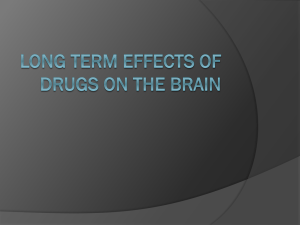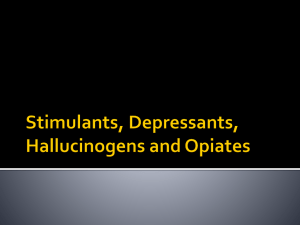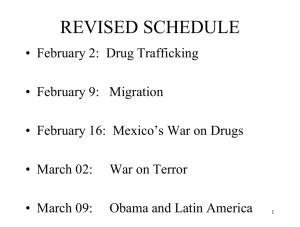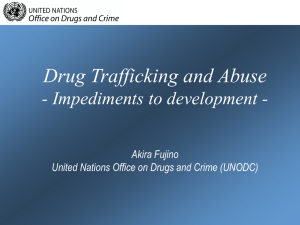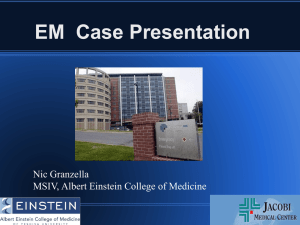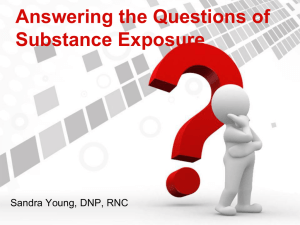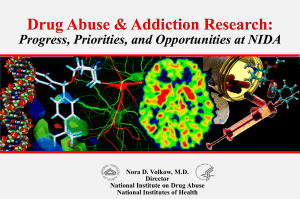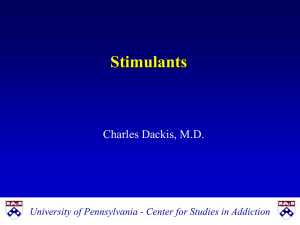chasing_the_dragon_grand_rounds2
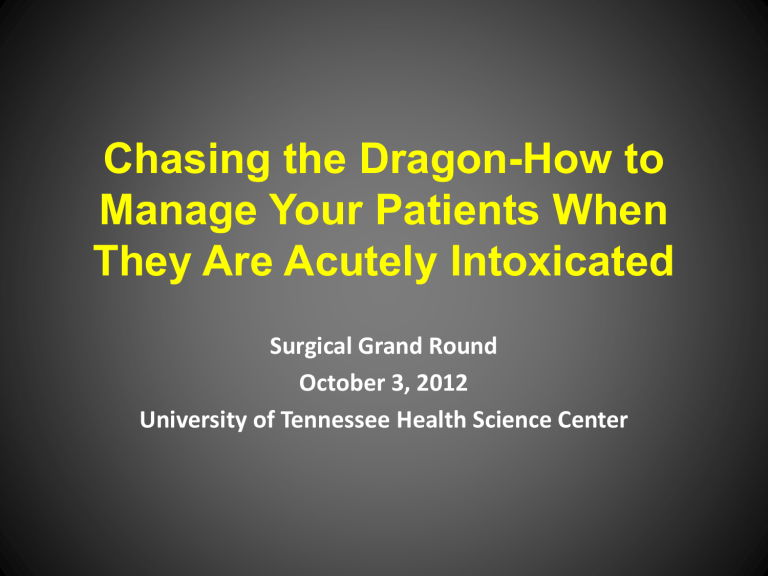
Chasing the Dragon -How to
Manage Your Patients When
They Are Acutely Intoxicated
Surgical Grand Round
October 3, 2012
University of Tennessee Health Science Center
Objectives
• Identify the signs and symptoms associated with acute intoxication from illicit substances
• Review the appropriate management of acute intoxication by the substances covered in this presentation
• Identify professionalism issues associated with the management of acutely intoxicated patients
• Most common drug encountered will be ethanol
• CH
3
CH
2
OH
• Focus of this talk will be on other illicit drugs
Marijuana
Marijuana
• Psychoactive properties due to delta-9-tetrahydrocannabinol (THC)
• THC content has increased from 1-5% in the 1960’s to 10-15% today.
• Typically causes euphoria with decrease in anxiety, alertness, depression and tension.
• Can cause anxiety, dysphoria and panic
• Perceptual changes such as colors being brighter and music more vid
• Distorted time and spatial perception
• Can cause hallucinations
• Mystical thinking, increased self consciousness, depersonalization, transient grandiosity, paranoia and other signs of psychosis can occur
Marijuana
• Decreases reaction time, impairs attention, concentration, short term memory and risk assessment.
• Impaired motor coordination and interferes with complex tasks that require divided attention.
• Impairment of cognition, coordination and judgment lasts much longer.
• Psychomotor impairment last for 12-24 hours
Marijuana
• Physiologic signs
– Tachycardia
– Hypertension
– Tachypnea
– Conjunctival injection
– Dry mouth
– Increased appetite
Cocaine
Cocaine
• Benzoylmethylecognine
• methyl (1R,2R,3S,5S)-3-(benxoyloxy)-8methyl-8-azabicyclo [3.2.1] octane-2carboxylate
• “Coca” from the coca plant and the alkaloid suffix“-aine”
• Crystalline tropane alkaloid
• Stimulant, appetite suppressant and local anesthetic
Cocaine
• Found in leaves of Erytholoxum coca plant
• People have been chewing the leaves of the coca plant for 2000 years with little risk of abuse
• 1860-Cocaine isolated by Albert Niemann
• Coca-Cola contained 0.75 mg of cocaine/ounce until 1903.
• Cocaine still available as a 4% or 10% solution for use as a local anesthetic
Cocaine
• 14 millions users worldwide, 6.4 million in
North America
• Usage in UK and Spain has reached the same level as that of the US
• Very little cocaine usage in Africa, Asia,
Eastern Europe and Oceania
• Most common illicit drug associated with emergency room visits (31% or 450,000 visits)
Cocaine
• Serotonin-norepinephrine-dopamine reuptake inhibitor or triple reuptake inhibitor (TRI)
• Has hydrophilic and lipophilic portions of the molecule. This allows it to cross the bloodbrain barrier easily
• Highly addictive due to effects on mesolimbic reward pathway
• Also blocks membrane voltage-gated sodium channels
Cocaine
• Two forms-base and salt
• Cocaine base-crack or free base. Low melting point (98°C) so it is easy to smoke. Water insoluble so can’t be used for injection
• Cocaine salt-High melting point (195°) so cannot be smoked. Water soluble so easy to inject and insufflate (snort).
• Rapidly taken up by most organs including liver, heart, kidney and adrenal gland.
• Found in blood, urine, hair, sweat, saliva, breast milk and meconium after usage
Cocaine
• Onset-inhaled or iv-seconds. Intranasal-20-30 min and GI-90 min.
• 95% is metabolized by hydrolysis of ester bonds.
Carboxyesterases in liver hydrolyze it to benzoylecgonine. Butyrylcholinesterase throughout the body hydrolyzes cocaine to ecgonine methylester
• 5% n-demethylated to norcaine by P450 system
• Eliminated in the urine, largely as benzoylecgonine. This is what is tested for in UDS
Cocaine
• Typical doses-12-15 gm orally (coca leaves), 20-
100 mg intranasally, 10-50 mg iv or 50-200 mg inhaled
• Intended effects-increased energy, alertness and sociability; elation or euphoria; and decreased fatigue, need for sleep and appetite
• Adverse effects-dysphoric mood (anxiety or irritability), panic attacks, paranoia, grandiosity, impaired judgment, psychotic symptoms such as hallucinations and delusions
Cocaine
• 40% of cocaine users suffer from sleep disturbance, weight loss, paranoia or hallucinations.
• Restlessness, agitation, tremor, dyskinesia, repetitive or stereotyped behaviors such as picking at the skin can also occur.
• Sensitization and tolerance can occur with chronic use of cocaine.
• Chronic cocaine abuse associated with cognitive impairment including visuo-motor performance, attention, verbal memory and risk-reward decisionmaking. It is also associated with suicide ideation and attempts
Cocaine
• When combined with ethanol, cocaine forms benzoylmethylecgonine or ethyl cocaine via transesterification.
• Ethyl cocaine half-life is 13 hours and is vasoconstrictive, cardiotoxic, dysrhythmogenic and neurotoxic.
• Inhibits dopamine reuptake as potently as cocaine
• 24% of cocaine is converted to ethyl cocaine when taken iv, 18% when insufflated.
Cocaine
• Monoamine reuptake inhibitor
• Na-channel blockade
• Excitatory amino acid stimulation
Cocaine
• Indirect sympathomimetic agent
• Stimulates α-1, α-2, β-1, and β-2 adrenergic receptors largely mediated by increases in norepinephrine and to a lesser extent epinephrine
• Preferential α effects on the cardiac and peripheral vasculature. Additional cardiac effects via β agonism
• Blocks the dopamine transporter protein, which pumps dopamine out of the synaptic cleft and into the presynaptic neuron
• Results in enhanced and prolonged dopaminergic effects on the postsynaptic neuron
Cocaine
• Euphoria associated with serotonin reuptake inhibition in CNS
• Slows or block nerve conduction by blocking membrane voltage-gate Na channels in nerves.
• In high doses, affects Na channels in the heart with prolonged QRS and negative inotropy.
• Increases concentrations of the excitatory amino acids glutamate and aspartate in CNS, particularly in Nucleus accumbens. Glutamate is main excitatory amino acid in the CNS.
Cocaine
• Acute Intoxication
– Agitation
– Dilated Pupils
– Euphoria
– Tachycardia and Hypertension
– Fever
Cocaine
• Causes arterial vasoconstriction and enhanced thrombus formation
• Causes tachycardia, hypertension, increased myocardial oxygen demand and increase vascular shearing forces
• Causes coronary vasoconstriction and 5% of patients who seek care in ED have myocardial ischemia
• High doses can lead to decrease LV function and heart failure.
• Can cause supraventricular and ventricular dysrhythmias
• Aortic dissection and rupture occur rarely
Cocaine
• Cause psychomotor agitation, seizures, coma, headache, intracranial hemorrhage and focal neurologic symptoms
• Psychomotor agitation can cause hyperthermia when peripheral vasoconstriction prevents the body from dissipating head. Mortality can be as high as 33% when hyperthermia develops.
• Seizures occur in 3-4% of cocaine-related ED visits
• Can get angioedema and pharyngeal burns during inhalation
• Cocaine uses have a high incidence of perforated ulcers
• Can cause ischemic colitis, intestinal infarction and metabolic acidosis.
• Intestinal obstruction-consider body-packing
Cocaine
• Differential Diagnosis includes
– Amphetamine Abuse
– Phencyclidine Abuse
– Hypoglycemia
– Hypoxia
– Alcohol and sedative-hypnotic withdrawal
– Neuroleptic malignant syndrome
– Serotonin syndrome
– Heat-related illness
– Thyroid storm
– Subarachnoid Hemorrhage
– CNS Infections
– Seizures
– Psychiatric diseases
Cocaine
• Treatment
– ABC’s-Avoid succinylcholine for RSI
– Cooling if hyperthermia present
– Benzodiazepine
– Phentolamine (only if hypertension refractory to benzodiazepine)
– IV fluids
– No β-Blockers
Heroin
Heroin
• Opium is crude substance isolated from opium poppy
• Opium has been used by humans since 4000
BC
• 1804-Friederick Sertürner isolated morphine
• 1874-Heroin (diacetylmorhine or morphine diacetate) synthesized by C.R. Alder White.
Added two methyl groups to morphine isolated from opium
Heroin
• Opioids activate specific transmembrane neurotransmitter receptors (μ,κ,δ) that couple G proteins.
• Activation of endogenous μ opioid receptors results in effects of reward, withdrawal and analgesia.
• 2.4 million people in US have used Heroin.
• Heroin has a half-life of 30 min.
• Duration of action 4-5 hours, due to active metabolites including morphine
• Heroin is metabolized to 6-monoacetylmorphine (6-
MAM) which is detectable on urine testing
Heroin
• Symptoms
– Depressed mental status
– Decreased respiratory rate
– Decreased tidal volume
– Decreased bowel sounds
– Miotic (constricted) pupils
Heroin
• Treatment
– ABC’s-Particular attention to airway and breathing
– Naloxone-0.2-1 mg depending on symptoms. 2 mg if cardiopulmonary arrest.
– Supportive care
PCP
PCP
• Phencyclidine or1-(1-phenylcyclohexyl)piperidine.
• 1926-first synthesized
• 1952-patented by Parke-Davis and marketed as
Sernyl.
• It is a dissociative anaesthetic
• Peak abuse was in the late 1970’s. 710 reported cases of PCP intoxication in the US in 2010.
• Early 1970’s-ketamine was isolated as a derivative of
PCP. It is 5-10% as potent as PCP
PCP
• Three primary sites of action in CNS
– N-methyl-D-aspartate (NMDA) receptor complex.
– Dopamine, norepinephrine and serotonin reuptake complex
– Sigma receptor complex
PCP
• PCP binds to NMDA receptor complexes in the hippocampus, neocortex, basal ganglia and limbic system.
• NMDA antagonism at these sites produces acute psychosis which mimics schizophrenia.
• It also leads to excess excitatory neurotransmitter release
(glutamate, aspartate and glycine) which can cause agitation and seizures.
• Inhibits reuptake of dopamine, norepinephrine and serotonin in neurons.
• These actions contribute to adrenergic and dopaminergic effects of acute intoxication
• Sigma receptor effects may explain psychotic, anticholinergic and movement abnormalities seen with acute intoxication
PCP
• PCP can be injected, insufflated, smoked and ingested
• PCP displays first order pharmacokinetics. Halflife of 7-26 hours.
• Primarily eliminated by liver
• Presenting symptoms are very variable.
Adrenergic stimulation is typical but patients may have CNS stimulation or depression.
• Patients can progress to coma unexpectedly.
• Tachycardia and hypertension are common.
PCP
• Patients can be hyperthermic or hypothermic.
• Psychomotor agitation is common as is violence.
• Associated with
– Rhabdomyolysis
– Seizures
– Hypoglycemia
– Prolonged comatose state
PCP
• Treatment
– ABC’s
– Benzodiazepines
– Droperidol or Haloperidol for refractory psychosis
– Barbiturate or Propofol for severe refractory psychomotor agitation or status epilepticus
– Supportive care for associated symptoms i.e. rhabdomyolysis
LSD
LSD
• Lysergic acid diethylamine
• 1938-synthesized by Albert Hofmann
• Originally marketed as anesthetic agent and adjunct for psychoanalysis
• Causes altered thinking processes, closed and open eye visuals, synesthesia, an altered sense of time and spiritual experiences.
LSD
• Usually ingested, although can be injected
• Dose is usually 20-30 mcg
• No documented deaths from intoxication
• May temporarily impair judgment and understanding of common dangers, making the user more susceptible to accidents
• Can cause dissociative fugue state with certain medications including lithium and tricyclic antidepressants
LSD
• Treatment
– Place patient in calm, safe environment
– May use benzodiazepines
– Avoid neuroleptics because they may worsen hallucinations and delusions
– Rarely, other supportive care
Methamphetamine
Methamphetamine
• Sympathomimetic amine and is a phenethylamine
• 1893-First synthesized
• 1923-Pharmaceutical formulations used to treat nasal congestion and asthma
• Used in World War II to increase alertness and decrease fatigue
• After cannabis, most widely abused drug in the world
Methamphetamine
• Dextromethamphetamine is a stimulant. It is
FDA-approved for treatment of ADHD and obesity. Trade name is Desoxyn.
• Levomethamphetamine is CNS-inactive and used as non-prescription over-the-counter nasal decongestant
• Methamphetamine has an additional methyl group compared to amphetamine which increases the lipophilicity and CNS activity of methamphetamine
Methamphetamine
• It is an indirect neurotransmitter and lacks direct adrenergic effects
• Incorporated into cytoplasmic vesicles where it displaces epinephrine, norepinephrine, dopamine and serotonin into the cytosol.
• These neurotransmitters diffuse out of the neuron and into the synapse where they activate postsynaptic receptors
• It also inactivates neurotransmitter reuptake transporter systems
Methamphetamine
• These processes result in adrenergic stimulation.
• The lone modulator of these effects is degradation by catechol o-methyl transferase
(COMT)
• Methamphetamine can be smoked, injected, insufflated, or ingested
• Methamphetamine is eliminated by cytochrome
CYP2D6 in the liver, other hepatic pathways and by the kidney
Methamphetamine
• Signs
– Diaphoresis
– Hypertension
– Tachycardia
– Severe agitation
– Psychosis
Methamphetamine
• Patients may appear malnourished, agitated and disheveled
• Violence is associated with intoxication
• Can see hypervigilance and akathisia
• Severe intoxication can lead to sudden cardiovascular collapse, seizures, altered mental status requiring intubation, rhabdomyolysis, cardiac ischemia, MI, cardiomyopathy and death
Methamphetamine
• Treatment
– ABC’s
– Benzodiazepines
– Antipsychotics (ziprasidone, droperidol, haloperidol)
– Neuromuscular blockade with nondepolarizing agents for severe hyperthermia. No succinylcholine.
– Other supportive care i.e. sodium bicarbonate, IV fluids, ACLS for cardiopulmonary arrest
MDMA
MDMA
• 3,4-methylenedioxy-N-methylamphetamine
• “Ecstasy”
• Member of the phenethylamines
• 1912-synthesized by Anton Köllisch at Merck
• Legal and unregulated in US until 1985
• 10-25 millions users worldwide similar to cocaine, amphetamine and opioids
• Associated with electronic dance music, raves, dance clubs and dance parties
• Induces euphoria, a sense of intimacy with others and diminished anxiety
MDMA
• Usually ingested
• Dosage is 50-200 mg
• Sympathomimetic amphetamine that increases release of norepinephrine and dopamine and blocks their reuptake
• Structurally similar to serotonin
• In addition to hypertension, tachycardia, hyperthermia,
CNS stimulation, MDMA can cause serotonin syndrome and SIADH
• Primarily excreted in urine and metabolized by CYP2D6
MDMA
• MDMA increases alertness, reduces fatigue, leads to feelings of increased physical and mental powers and euphoria
• Can also cause agitation, nausea, bruxism, ataxia, diaphoresis, blurry vision, tachycardia and hypertension
• Rarely causes hypertensive emergencies, intracranial hemorrhage, MI, aortic dissection and dysrhythmias
MDMA
• Treatment
– ABC’s
– Most effects are self-limited over 4-6 hours
– Do not fluid resuscitate until sure the patient is not hyponatremic
– Other supportive care
Bath Salts
Not These
These
Bath Salts
• Usually refers to designer drugs which are similar to cathinone. An example is mephedrone.
• Cathinone is found in Catha edulis or khat
• The chemical composition of these substances is very variable but usually contain a cathinone such as methyenedioxypyrovalerone (MDPV), methylone or mephedrone
• Very little is understood about how they interact with the brain or their metabolism
Bath Salts
• Behave similarly to amphetamine by increasing dopamine, serotonin and norepinephrine
• Less able to cross blood-brain barrier due to the presence of a beta-keto group
• Can be inhaled, insufflated, injected or ingested
• Users can experience headache, heart palpitations, nausea and cold fingers
• Hallucinations, paranoia, panic attacks, violence, MI and kidney failure can occur
• Symptoms include dilated pupils, involuntary muscle movement, tachycardia and hypertension
Bath Salts
• Treatment
– Largely unknown
Smiles
Smiles
• 2C-I or 2,5-dimethoxy-4-iodophenethylamine
• Member of the phenethylamine family
• Synthesized by Alexander Shulgin
• Usually ingested
• Effects usually occur within two hours and last 4-
12 hours
• Hallucinogenic and Entactogenic effects
• Can cause muscle tension, nausea and vomiting
• Symptoms include dilated pupils, tachycardia and hypertension
Professionalism
• Professional competence is the habitual and judicious use of communication, knowledge, technical skills, clinical reasoning, emotions, values and reflection in daily practice for the benefit of the individual and community being served
– Epstein RM and Hundert EM. Defining and Assessing Professional
Competence. JAMA. 2002; 287:226-235
My Thoughts
• Patient doesn’t have to earn the right to care
• Treat patient with dignity
• Protect yourself and staff from those who are violent
• Use law enforcement when necessary
• Duty to society
• Physicians at increased risk for substance abuse

